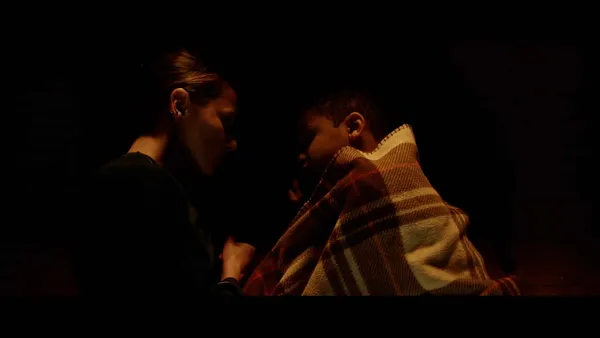 |
| Sarah McGuire and Patrick McGee in They Wait In The Dark |
One of the hidden gems at this year’s Frightfest, Patrick Rea’s claustrophobic thriller They Wait In The Dark is a small budget film which punches well above its weight. It follows troubled mother Amy (Sarah McGuire) as she takes her young son Adrian (Patrick McGee) across the country to the now-abandoned house where she grew up, trying to hide him from her violent partner Judith (Laurie Catherine Winkel). There are other things contributing to Sarah’s disturbed state of mind, however, and the house itself might represent the biggest danger of all. After seeing it I dropped Patrick a line and arranged to chat, beginning by asking him how he managed to create a film which looks so polished and impressive with really limited resources.
“I'm lucky enough that I've worked with a lot of the same people over the last decade,” he says. “My DP [Hanuman Brown-Eagle], actually, he and I worked together since 2006. So we did a lot of short films, and we've done several features together. He shot I Am Lisa, which was at Frightfest in 2020, and then he's done other movies with me as well, and we work really well together. Because we've worked together for so long, there's a shorthand, and we can kind of read each other's minds, which helps keep the schedule moving, because I had like 12 days to film this movie.
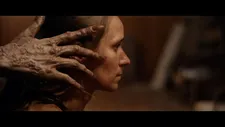 |
| The house may not be as safe as it seemed |
“I also wrote it in a way that I thought would work with a short schedule. I always tell people ‘If you want to do a movie in 12 days, don't put a car chase, don't do a bunch of crazy stunt work and stuff.’ So I was like, ‘Okay, we're going to make it a haunted house movie with like, three locations and four lead actors.’ So I wrote the script in November of 2020, just because I had a lot of time. I recently had knee surgery so I was just sitting – I was like, ‘I'm going to write a script,’ and the producer who financed the movie reached out to me, and she was like, ‘Look, I want to do something for this amount of money.’ So I was like, ‘Okay, well, I'll write a haunted house movie,’ because generally speaking, those movies can be done at a relatively low budget.
“That being said, the challenge I had was finding an idea that I thought was original, because every haunted house movie has been done. I always tell people whenever there's a haunted house movie, most of the time, I'm like, ‘Why are you still in the house? Why don't you just leave?’ You know. So I had to come up with a reason why the character of Amy and her son Adrian are staying in the house because it was like, ‘Okay, if I make up there's an extra threat from the outside, and she's running from her ex girlfriend, and then there's a threat on the inside, she's sort of pinned between two threats, one very real and one supernatural,’ which I thought was a little bit more interesting of a movie.
“In terms of keeping the movie looking so nice. I have a fantastic colorist. He coloured the movie, he did a fantastic job, and everybody just works really well together. I wrote this script for Sarah McGuire. I've worked with her on several short films and so I had come up with this idea for her, and I knew that she could pull it off. And then I cast three actors I've never worked with before page: Paige Maria, who plays Jenny, and then Patrick McGee to play Adrian and Laurie Winkel to play Judith. Laurie I've known for 15 years, maybe more, and she had always been like, ‘Hey, what are we going to work together?’ I'm like, ‘I'm waiting for the right time.’ And the time came, and she she nailed it.”
Did he know the locations before he started?
“No. In fact, the house was a happy accident because we were really struggling to find a house location because it had to be just right. It had to look lived in and deserted. But that's hard because then it's like okay, do you go to a realtor and say, ‘Hey, can I borrow this house for a month?’ What if they sell the house and then you have to leave? And also it's hard to go to somebody and say, ‘Hey, can we invade your space for ten days, and then put you guys in a hotel, and just completely make your house look like it's been deserted for 15 years?’
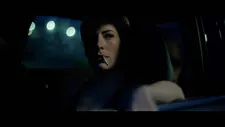 |
| Laurie Catherine Winkel in They Wait In The Dark |
“It turns out I had a friend, she had a house, and it was outside Topeka, Kansas, kind of like 20 minutes outside Topeka, on a farm. And she was trying to sell it, they had been actually not touched it since the mid 2000s. And so when I walked in, I'm like, ‘This is perfect.’ It was almost too perfect, to the point where we were like, ‘Okay, we have to actually clean this place up a little bit,’ because it was not safe. You know, for the crew. And I was like, ‘Alright, everybody's going to be breathing in dust and stuff.’ And we were going to be wearing masks anyway, because of Covid. But it had to look still look lived in and deserted. So a lot of the stuff that you've seen in the movie was there already, the bed frame, all the junk, all that stuff was already there, and it fit the movie perfectly.
“So then the challenge becomes ‘Okay, I guess the crew has to migrate to Topeka,’ because Topeka is about an hour and 20 minutes from Kansas City, depending on what part of the city you live in. So we knew that we couldn't drive there every day and then drive back. That would be almost three hours. We had to put everybody up in a hotel in Topeka and make it work. And I'm glad we did because it was the perfect location.”
We discuss the performances in the film, and I note that I was particularly impressed by young Patrick McGee in his first film role.
“Well, he comes from a long line of actors in Kansas City,” the older Patrick explains. “His grandfather is one of the more well known theatre actors. His grandma has also been in a lot of stuff here in town. And so he just fell right into place. I was a little worried because, you know, he's eight, and we can only work with him for a specific amount of time. And he impressed me so much. Like, it was 4am., and he's still running circles around us. And we're all really tired, and he's drinking Coca Cola and he's like, ‘Alright, I want to keep filming.’ And we're like, ‘Well, we're done. We're done for today.’ So it ended up being that he was actually outlasting all of us in terms of energy, which was good.
“He was super easy to work with, which was helpful because everybody had to nail it in three or four takes because I didn't have a lot of time. So I couldn't sit there and do 20 takes of a scene; I had to get it done. Luckily, all the actors came prepared and did a fantastic job.”
There's some quite emotionally distressing and difficult material that the kid has to handle.
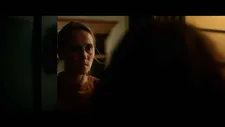 |
| Amy receives a visitor |
“He handled it very well,” he says. “Everybody who's watched the movie has asked me ‘Oh, what was it like on set? It's very intense.’ And I'm like, ‘Wait a second, everybody was just joking around.’ That's kind of the way it was. And you know, I always tell people, our sets are fun and jovial. There was one day – it was the target practice day – when we were a little stressed because it was 100 degrees in the shade, and we have a scene where we're working with prop weapons, which is very stressful. And we were very, very careful and took all precautions, but everybody was a little stressed out that day. We were like basically like ants under a magnifying glass, it was so hot. And you know, when you're working in extreme heat, your people get kind of frustrated.
“Other than that, every day was just a real joy. Some of the schedule was like 5pm to 5am shoots or 5pm to 4am or whatever, and we would all go back to the hotel and then we'd be like, ‘Oh, let's go have a beer and talk on the roof.’ You know, they had like a little space up on the hotel where people can hang out and stuff. So people were hanging out until sunrise and asleep till three or four in the afternoon, and then we'd start all over again. That was great.”
One of the strengths of the story is the ambiguity of its central character, who sometimes seems desperately vulnerable and sometimes seems as if she might be a danger to the boy herself. I ask how he developed the character and he explains that he wrote the script ten pages at a time and kept sending them back and forth to Sarah and producer Meagan Flynn. “It was tricky because obviously I didn't want to give away too much as we went along. The movie builds, and it needed to. I didn't want to like rush things. And I had worked with Sarah on another short film where her character has ambiguity. So it was easy for me to figure out how to interweave that as as the story progressed.
“Working with Sarah is helpful because I can send her 10 pages of the script, and she'll give me feedback, so we were able to kind of massage things. There were a couple of scenes that we actually cut out of the script that were a little bit less ambiguous. I think it actually helped the movie. It also helped with the fact that we didn't involve fire. And I'm like, ‘I can't do that. That's too much work in that short period of time.’”
 |
| The house may not be as safe as it seemed |
And then there’s Laurie’s work. It’s one of those performances which just crackles with danger, yet still fascinates.
“When I wrote that character, I had nobody in mind for it,” he says. “I was struggling to figure out who was the right fit, because it's a tough part to pull off. There's layers to it and there's a lot of grey area. Laurie auditioned for it and I was like, ‘Alright, she's perfect.’ It was one of those things where she had the right look, she was the right balance of sympathetic and intimidating.
“The scene that we shot in the gas station was was probably the most fun because that is her introduction scene. We shot that scene in Leavenworth, Kansas. I couldn't shut down the gas station because obviously, I would have to pay for all the money that they would have made that night. So were filming that scene over and over and over again in the parking lot, and people started gathering around. It became this thing where everybody in town was watching and talking about it.
“But yeah, she just nailed every day. She came very prepared. I did not have to really give her too much direction, because I think she understood the character right off the bat, and that was very helpful. I was fortunate. They always say casting is so important, and it really is. If you get the right people, it's going to make your job a lot easier when something else happens that you can't control, like weather, or whatever. As a filmmaker, you have to roll with the punches, and when there's a curveball thrown at you. And I think if you get the casting right, you're in a good place, because you can deal with all these other things. I mean, I'm also helping produce and schedule and all that stuff, so I've got other things I’m also worrying about besides directing.”
We discuss his background as a filmmaker and how he got to this point.
“This is my third feature at Frightfest. I had a feature in 2016 called Enclosure that started Fiona Dourif and Jake Busey, and then when it got released in the United States, they changed the title to Arbor Demon, which I was honestly not super stoked about. But I was pleased with the film, and that movie is currently on Paramount Plus and other various streaming services. And then, in 2019, I got hired locally for I Am Lisa, which was shot entirely again in Kansas City on a very minimal budget. And that premiered in Frightfest in 2020, and that movie is on Peacock here in the United States, and it's on different streaming services as well.
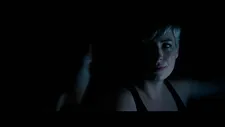 |
| Judith tells her side of the story |
“I grew up in Nebraska but I went to the University of Kansas for film school, and now I'm living in Missouri. I'm on the Kansas City, Missouri side of things and I’ve just been making films ever since. Enclosure was actually shot in South Carolina, in Charleston, but everything else has been around the Kansas City area. Right now I'm just trying to figure out what I'm going to do next. Getting financing is always a challenge, especially when, I would say, the economy isn't great at this point. It doesn't help getting money for for a movie.”
What he looks for in a project is something about it that’s different, he says.
“In the case of this movie I wanted to make a haunted house movie but I wanted it to be feel different, like something I hadn't seen before, so I decided to kind of combine a supernatural haunted house movie with a domestic thriller. Okay, everything's been done to some extent, but I’m always looking for a new vantage point. I Am Lisa was interesting, because the guy who wrote it approached me and he's like, ‘It's a werewolf revenge movie.’ And I'm like, ‘Oh, that's kind of interesting.’ It was a female driven movie. And then Enclosure, which was almost entirely inside of a tent. It's like three characters inside of a tent and there's something circling the tent and not attacking them, but they can't leave the tent. It's almost like a camping movie with a slightly different vantage point.”
This is very much a female driven movie, I observe – and not so long ago, people would have been nervous about depicting a same sex couple in a situation like this, because there was such an urgent need for positive representation. It feels to me that we’ve made real progress when there’s room for LGBTQ people to be represented in all their complexity, even as villains.
He nods. “Sarah is part of the LGBTQ community. She just married her girlfriend of four years. So yeah, I mean, that was something we talked about. I think that honestly, their sexuality has nothing to do with it. If you were to replace them with a straight couple, the story stays the same. I feel like it definitely is a progressive movie, I think it definitely moves things forward. There's always going to be somebody who is upset or takes it completely the wrong way. The movie is entirely about ending the cycle of abuse, and so I think people when they see it, you know, if they are looking for the wrong thing they might find it. But ultimately, that's what this movie is about, not about sexuality. They just happen to be a same sex couple.”
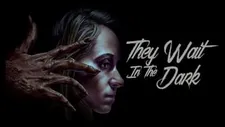 |
| They Wait In The Dark poster |
Talking about the cycle of abuse, it’s worth noting that there's not just the one child in this film – there's also a second, because there are flashbacks to Sarah's childhood. How did that side of the film come together?
“Meagan plays the mom in those flashbacks, so she was producer and actor in that scene. That was kind of fun. We cast an actress whose name is Brinklee [Wynn]. We needed to find somebody who was like, if you put Sarah and her side by side, she could be the grown up version of his little girl. So I had to find somebody who looked like her. In the pictures you see Brinklee, the younger version of Sarah, who's supposed to be with the young version of Jenny, the best friend, and we use the actress Paige's actual daughter for those photos.
“We did the flashbacks last because I had to clean up the space and make it look like it wasn't deserted. So we did the flashbacks from the very last day of shooting. We had to make the bedroom now look nice, so we had to put on the mattress, make the bed, do all that stuff, because in the rest of the movie, it's just a frame, you know? And the same thing with the kitchen. We had to go in and clean off all of the glass on the cabinets and make it look nicer. So that was strategic in our scheduling.”
Getting to the festival again means a lot.
“I always warn people that it's a slow burn,” he says. “I'm thrilled that it's playing at Frightfest – for me that's a complement to the work that everybody put into it. Because ultimately, getting into the film festival, you kind of want to like ‘Okay, we've made something that I think a lot of people are going to like.’ But it's not a gore fest, it's not a horror comedy. It's very much a psychological thriller and a ghost story. So it takes some time to build, but I think it has a good payoff, and I think that it'll leave people thinking at the end. I mean, it'll probably stick with you. I hope that you'll still be thinking about it afterwards. What I hope for is that when the movie is over, people have something to discuss, but it's definitely not a horror movie where people can just drink beer and laugh and clap at all the gore and stuff – it’s a completely different kind of movie.”





















